
“When we hear in the news that some giant mine is going to open in interior Alaska, it’s hard to understand what that means—reading this fine novel makes it easy to figure out why ripping open our last wild places is such a sad, consequential decision.” –Bill McKibben
“Anne Coray’s Lost Mountain is pure Alaska gold. Lost Mountain captures all the nuances and complexities of what it’s like trying to live an idyllic life in a land rife with competing interests and struggles. In this beautiful debut novel, Coray reveals important truths about what is worth fighting for in both love and life.” —Don Rearden author of The Raven’s Gift
“With a deft combination of complex characters and environmental reality, Lost Mountain explores how the looming prospect of a mine envelops the lives and relationships of a fictional artists’ community. Coray examines the cost of compromise and the sustainability of love.” —Erin Mckittrick, author of A Long Trek Home
“This beautifully written novel and its descriptive
narrative totally encapsulate the small Alaskan town of Whetstone Cove and its
residents. The characters literally jump from the pages; they are both engaging
and possess many interesting layers. . . The novel highlighted the beauty of
nature, the importance of caring for the environment, and the results of
humanity’s greed for money and power.”
–Readers’
Favorite
“Coray’s
tale will engage anyone interested in the continued mining debate, the Green
Movement, and the consequences of irreversible land damage and climate change.
Gripping and captivating, emotional and poetic, with its implicit nods to the
philosophies of John Muir and the photography of Ansel Adams, this book stands
tall like the Alaskan alders and spruces. It’s a page-turner, sure to keep
readers guessing and engaged from the first page until the very last.”
–US Review
of Books
“Lost Mountain, by Homer and Lake Clark writer Anne Coray, is a book from the geographic heart of the biggest Alaska mining controversy of the 21st century–so far. . . In this novel, she has created a community of creative spirits, an arts and crafts village which has many of the same concerns as Native villages in the region. . . I care about her characters; her natural history observations are both sweet and sharp.”
–Peninsula Clarion/Homer News
“Terrific, a wonder–not only a strong story but filled with nature, with knowledge of the seasons, plants and creatures. And people–memorable characters. Lost Mountain is a testament to faith and love.”
–William Heyen, author of Shoah Train
Available at Homer Bookstore, rivercity books, Fireside Books, as well as other independents. Also B&N and Amazon
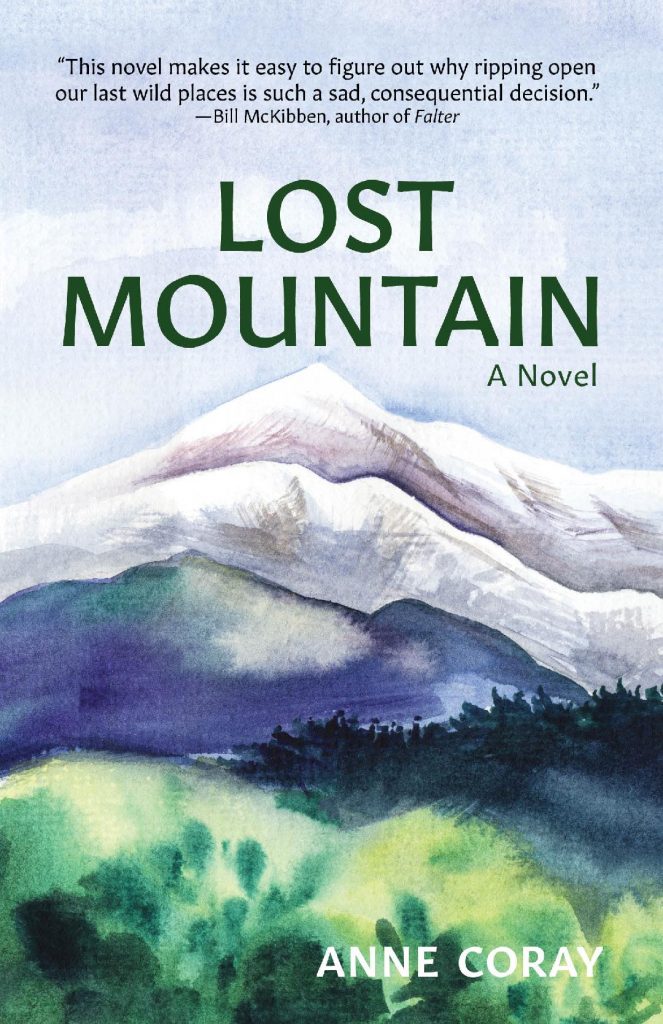
Poetry Books
Late Fall Bucolics (The Poetry Box, 2022), Finalist
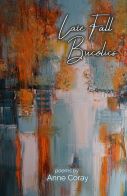
Anne Coray, a lifelong Alaskan, is keenly aware of climate change. The 24 sonnets of Late Fall Bucolics explore global warming and examine the aftermath of fire through Greek myth as well as the history of match making, with its devastating effects on factory workers. With nods to DaVinci and Matisse, she weaves in themes of art with her idea that humans are painting (or remaking) our earthly landscape. Many of these poems were not only inspired by poets such as Blake, Neruda, and Plath, but also pay homage to today’s young activists, such as Greta Thunberg
I’ve been an admirer of Anne Coray’s tough, lively nature poems for many years. In Late Fall Bucolics the natural world again takes center stage, a planet especially raw, turbulent, and angry, as if lashing out in its own last defense. These poems chart an elemental storm of fire and ice, of seasons out of whack, a terrain under siege by human ignorance. “All will burn, but how magnificent the color.” Woven throughout is a complementary examination of landscape painting (by amateur and master alike)—the inadequacy of art’s mimicry offset by the compulsion to witness, to fix on canvas some testimony to the terrible beauty that is quickly and forever passing. Ms. Coray seems energized by the parameters and possibilities of the sonnet in this linked sequence, and despite her contention that it is “too late / For remedy,” the consistent flashes of play here, the continual linguistic energy, and most centrally the poet’s enduring gaze—even at her own culpability—create a voice urgent and desirous, perhaps even hopeful, that “something remains of place.” —Gaylord Brewer, author of Worship the Pig
A Measure’s Hush (Boreal Books, 2011)
Finalist, White Pine Press
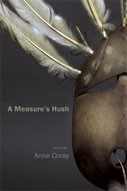
Coray is a poet who lives with wind and knows—however much the roots of things might tunnel and take hold—we will be borne off. Her new poems move through depths of elegy: the green scrub and drought of southwestern Alaska; the loss of a brother; meditations on paint and richnesses of gray, on language and everything it cannot capture. She is always attentive to the way the world resists vision. Snow falls on snow, a white bird rests in a white field, the ground “[does] not rise in greeting.” Through a radiant patience, Coray is present for those moments when something cracks and the air spills into crystal ash, the fern in the rain “breathes the silver message.” Without self-pity, and with immense trust, she shows us, sometimes quietly, how death arranges us to live. —Joanna Klink, author of Circadian
The Egyptians Had it All Wrong
(Poetry Foundation Audio)
Violet Transparent (Future Cycle Press, 2010)
Finalist, Rooster Hill Press
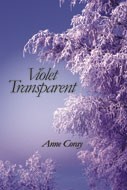
In “This Close to Permanence” Anne Coray looks into a lake and thinks, “Nothing I’ve made has such beauty of fusion.” Several poems later she asks, “Is it possible, then, to reconcile division?” This, then, is the struggle of this fine poet: by way of the poem, despite lament and anger over our accelerating natural and spiritual losses—to achieve a sustaining vision of language and place that might hold for her listeners, too. Nothing, of course, is certain—”Ask the great auk about guarantees”—but poem after poem here achieves an earned stay against despair, against resignation. I’ve read Violet Transparent with admiration and gratitude. —Willliam Heyen
Violet Transparent is an exact, and exacting, map of the heart’s north country, where “the snow-graced peaks reflect/ what most of us come to know:/ the best we can have is the welcome/ of looking through.” Anne Coray knows such welcome, and in these poems she proves herself to be a fearless and inventive explorer of a land that most of us but glimpse in dream or from a great distance. Hers is “a furious faith/ in the righting of wrong.” Violet Transparent helps us see the world aright. —Christopher Merrill
Bone Strings (Scarlet Tanager Books, 2005)
Finalist, 3rd Place, Bright Hill Press Book Competition
Finalist, Water Press and Media First Book Competition
Semi-Finalist, Winnow Press First Book Competition
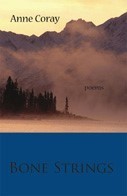
Anne Coray’s poems are deeply satisfying for their graceful combination of devotions, to the natural — animal/vegetable/mineral — and to the way nature resonates in us, the humans who live in a “sacred space.” She is keenly observant, sensitive without swooning, and conveys both the loveliness and the brutality of her world in a complex and disciplined language. —Rosellen Brown
Bone Strings contains some of the finest poems I have read by an Alaskan poet in recent years. They are not the poems of a city visitor, but of a resident in the truest sense, one who can speak with a deep sense of place, of life lived and remembered from day to day, season to season. The poems deserve many readers. — John Haines
Anne Coray’s poems in Bone Strings emanate with an intuitive sense of the Alaskan wilderness where she grew up. As one who is intimate with landscape, she is able to bypass the tendency to conceive wilderness as a pristine, magical presence. Instead, through her poems, she meanders the fractured line between harshness and beauty. She readily confronts the odds of survival and exposes the reader to a certain reality not only about the wilderness of nature, but also about the wilderness of self. —Katie Kingston, Poets West Review
Crosscurrents North (University of Alaska Press, 2008)
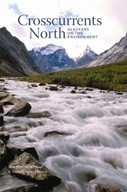
Crosscurrents North is a beautiful, heart-breaking, and desperately important book. What the book says—in the measured tones of Native elders, in the wind-scoured words of Alaska’s fine writers, in the blunt speech of trappers and fishers—is this: ‘There are people who love this bountiful, bruised land. Help us defend it. For all time.’”–Kathleen Dean Moore
This book is a pleasure. It brings to life in page after page the breathtaking richness and power of life in Alaska. It is full of writing of great beauty, intelligence, and force. And it is, of course, a necessary book. —Robert Hass
If the land has the power to teach us—and I believe that it does—then Alaska is the greatest master teacher in North America and this anthology gathers the voices of some of her most eloquent students. —Alison Hawthorne Deming
Lake Clark National Park & Preserve (Alaska Geographic, 2009)
First place in the Book Category, National Association for Interpretation Media Competition, 2010
Media and Partnership Award, Association of Partners for Public Lands (APPL), 2010
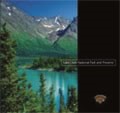
Lake Clark National Park and Preserve is the essence of the north in one national treasure. Within its borders, wildlife and people roam over tundra, along streams and lakes, near the coast, and through vast forests—nearly all of the habitats found in Alaska. The Dena’ina Athabascan name for Lake Clark itself is Qizhjeh Vena, translating roughly “many peoples gather lake.” The Dena’ina know that this lake of rich resources, which enticed people to gather at its shores, is the nucleus, the starting point, from which grandness and diversity radiate out.
Where Water is Gold (Braided River, 2016)
by Carl Johnson
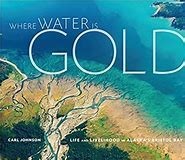
Essay: Moving with the Seasons by Anne Coray & Steve Kahn
Combines photos, interviews, science, and prose to reveal the cultural, natural, Native, and historical richness of Bristol Bay.
Conservation in competition with development is a well-worn theme in Alaska, and nowhere is this more apparent than in the battle over Bristol Bay.
Where Water Is Gold illustrates just what is at stake through Carl Johnson’s stunning photography and informative and lyrical essays by Bill Sherwonit, Nick Jans, Steve Kahn and Anne Coray, Dave Atcheson, and Erin McKittrick.